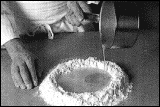
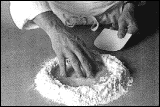
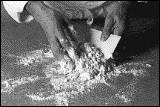
300 g (10 oz) flour
7 ml (1.5 tsp) salt
150-170 ml (5-6 fl oz) cold water
30 ml (2 tbsp) melted butter
1 egg, slightly beaten, for glazing
A well-make puff pastry is one of the great delights of the French kitchen. Butterly, flaky and rich without being heavy, it is hardly more difficult than simple shortcrust pastry but always impressive.
The principle behind the pastry is to create many layers of dough and butter by folding and turning the two together. (Unlike short pastry, the butter is not incorporated into the dough but rather folded into the layers).
It is crucial that the butter does not melt while the pastry is worked. Therefore, you must work as quickly as possible (particulary if your kitchen is hot) and on as cold surface as possible. Professisional pastry chefs use a refrigerated marble. You need not to go that far. Since you want an evenly layered pastry, it is important that you always roll it to the same thickness and that the edges be very straight and even (this takes some practice!)



1) Sift the flour into a mound on a cool work surface and make a well in the centre. Add the salt, water and melted butter to the well.
2) Mix with four fingers until the salt dissolves.
3) Use a plastic pastry scraper to pull the flour into the well and mix until blended, adding rhe remaining water if the pastry is dry.
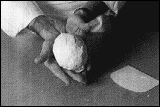
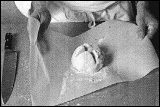
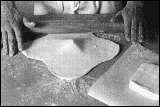
4) Work the pastry into a sticky ball with the pastry scraper.
5) Make an X-shaped incision on top of the dough, wrap in lightly floured baking parchment or tea towel, then refrigerate for about 30 minutes. This is the détrempe.)
6) Sandwich the remaining 200 g (7 oz) butter between 2 sheets of baking parchment or greaseproff paper and tap with a rolling pin until softened to the same consistency as the détrempe. Form the butter into a square about 2 cm (3/4 inch) thick. Place the ball of pastry on a lightly floured work surface and flatten slightly with the palm of your hand. Press the rolling pin into the top edge of the pastry and roll out an "arm". Give the dough a quarter turn and roll out another "arm". Continue to turn and roll twice more until the pastry is in the shape of a cross. It should be mounded in the centre, tapering out the 4 arms.
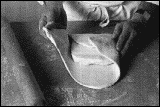
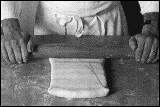
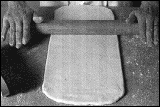
7) Place the square of butter on the mounded centre of the pastry and fold in the arms, stretching the pastry slightly to seal in the butter. (The 4 thiknesses of pastry on the top should be approximately the same thickness as the mound of pastry under the butter.)
8) Lightly tap the top of the pastry with a rolling pin to seal the edges and to enlarge and flatten the square a little. (this is the pâton. Then roll out the pastry to a long rectangle about 17.5 cm (7 inches) wide and 52.5 (21 inches) long.
9) The edges of the rectangle should be even and straight.

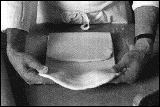
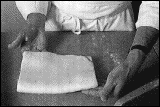
10) Fold the bottom third of the rectangle up toward the centre, carefully aligning the edges. Brush off any flour.
11) Fold the top third down to make a neat square and brush off any flour.
12) You will have a neat square of pastry with the fold on the bottom.
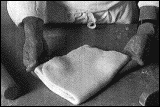
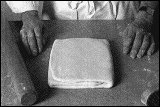
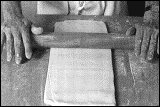
13) give the square a quarter turn to the left. for maximum rising it is important that you always rotate the pastry in the same direction so the the seam is always on the same side.
14) The fold should then be at the side.
15) Roll out the pastry into a long rectangle.
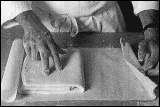
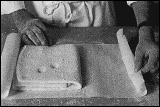
16) Again fold into thirds. Gently press 2 fingertips into the pastry to indicate that 2 turns have been completed.
17) Wrap the pastry and refrigerate for 30 minutes.
Give the pastry 2 more turns. Then mark it with 4 fingerprints to indicate a total of 4 turns have been completed. Rewrap the pastry and return it to the refrigerator for another 30 minutes. (After 4 turns the pastry may be refrigerated for 2 days or frozen.) Give the pastry another 2 turns and mark it with 6 fingerprints. Then wrap and refrigerate it for 10 minutes more before rolling out for shaping and baking.